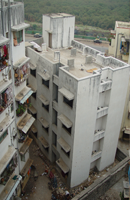| |
| Slum Redevelopment |
| |
| Projects in a nutshell |
| |
| |
 |
|
| Watch the Demolition to Development story on Youtube |
|
|
| RAJIV INDIRA, DHARAVI, MUMBAI, 2002 |
| |
This experimental project, the first rehabilitation taken up by slum dwellers themselves, set many precedents: a large private bank undertook a large, high-risk loan to a community organization, with a loan guarantee from Homeless International; the 14 foot ceiling-height and the large corridors and landing spaces were unique design concepts that have been adapted for other projects; and most importantly, the completed project has set a precedent for community-led processes.
Rajiv Indira: Rehab building (1) with two wings A&B and 108 units were constructed on the plot once occupied by the Rajiv Indira Society, towards the back of the overall plot area. And Ganga society which was pavement dwellers affected by the road widening project were also accommodated in the building. Since the society did not have a access road, the plans were amalgamated with Suryodaya society, whose developer had abandoned the project and who were in the front part of the plot facing the road. Four buildings have been completed, the fifth ‘for sale’ building is yet to be built. Since facing the property is the Mithi river, 50% of site affected by CRZ II rules so FSI was 1.33 instead of 2.5.
|
|
| |
|
|
| |
|
|
|
| |
|
| |
| |
|
 |
 |
 |
 |
 |
| |
|
|
|
| MILAN NAGAR, MUMBAI, 1999 |
RAJIV INDIRA,
MUMBAI, 2002 |
BHARAT JANTA, MUMBAI, 2002 |
OSHIWARA-2,
MUMBAI, 2009 |
| |
|
|
|
 |
 |
|
|
| |
|
|
|
| KANJURMARG-3, MUMBAI, 2010 |
MILAN NAGAR Phase 2, MUMBAI, 2013-ongoing |
|
|
| |
|
|
|
|
|
| |
|
| |
| Policy + Impact |
| |
In India, FSI (Floor Space Index) to cross subsidize construction by developers is being undertaken in Bombay, Pune and Nagpur in Maharashtra where a 1995 state policy for this purpose was enacted. Under the Slum rehabilitation scheme, NGOs, an additional incentive to build rehabilitation housing in exchange for on site floor space index increases in form of sale units and transferable FSI increases in the form of TDR. Households do not make a financial contribution but their agreement to allow their present dwellings to be torn down is seen as their contribution in lieu of their investments of the past. Earnings from TDR and the sale of market-rate housing are used to pay for construction costs; but a more important contribution of SRA is to provide security of tenure for slum dwellers.
The Alliance has taken up these projects with the following intentions:
|
01 To demonstrate that NGOs can design solutions where housing is built for communities and not market interests
02 To develop dialogue and negotiations with financial institutions to blend funds
03 To capacitate community cooperatives to manage housing after construction
04 To develop recommendations for government to improve and refine the policy to reach out to more households and settlements.
05 To explore ways to adapt and change some aspects to make this strategy work in other cities and other countries. |
| |
| |
| |
| |
| |
| |
| |
| |
| |
| |
|
|